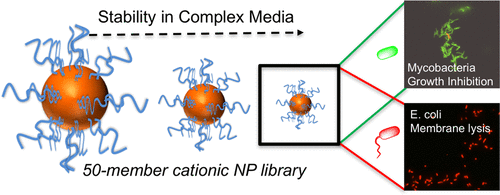当前位置:
X-MOL 学术
›
Biomacromolecules
›
论文详情
Our official English website, www.x-mol.net, welcomes your
feedback! (Note: you will need to create a separate account there.)
Multivalent Antimicrobial Polymer Nanoparticles Target Mycobacteria and Gram-Negative Bacteria by Distinct Mechanisms
Biomacromolecules ( IF 5.5 ) Pub Date : 2017-12-15 00:00:00 , DOI: 10.1021/acs.biomac.7b01561 Sarah-Jane Richards 1 , Klea Isufi 2 , Laura E Wilkins 1, 3 , Julia Lipecki 1, 2 , Elizabeth Fullam 2 , Matthew I Gibson 1, 3
Biomacromolecules ( IF 5.5 ) Pub Date : 2017-12-15 00:00:00 , DOI: 10.1021/acs.biomac.7b01561 Sarah-Jane Richards 1 , Klea Isufi 2 , Laura E Wilkins 1, 3 , Julia Lipecki 1, 2 , Elizabeth Fullam 2 , Matthew I Gibson 1, 3
Affiliation

|
Because of the emergence of antimicrobial resistance to traditional small-molecule drugs, cationic antimicrobial polymers are appealing targets. Mycobacterium tuberculosis is a particular problem, with multi- and total drug resistance spreading and more than a billion latent infections globally. This study reports nanoparticles bearing variable densities of poly(dimethylaminoethyl methacrylate) and the unexpected and distinct mechanisms of action this multivalent presentation imparts against Escherichia coli versus Mycobacterium smegmatis (model of M. tuberculosis), leading to killing or growth inhibition, respectively. A convergent “grafting to” synthetic strategy was used to assemble a 50-member nanoparticle library, and using a high-throughput screen identified that only the smallest (2 nm) particles were stable in both saline and complex cell media. Compared with the linear polymers, the nanoparticles displayed two- and eight-fold enhancements in antimicrobial activity against M. smegmatis and E. coli, respectively. Mechanistic studies demonstrated that the antimicrobial particles were bactericidal against E. coli due to rapid disruption of the cell membranes. Conversely, against M. smegmatis the particles did not lyse the cell membrane but rather had a bacteriostatic effect. These results demonstrate that to develop new polymeric antituberculars the widely assumed, broad spectrum, membrane-disrupting mechanism of polycations must be re-evaluated. It is clear that synthetic nanomaterials can engage in more complex interactions with mycobacteria, which we hypothesize is due to the unique cell envelope at the surface of these bacteria.
中文翻译:

多价抗菌聚合物纳米颗粒通过独特的机制靶向分枝杆菌和革兰氏阴性菌
由于传统小分子药物出现抗菌耐药性,阳离子抗菌聚合物成为颇具吸引力的目标。结核分枝杆菌是一个特殊的问题,其多重耐药性和总体耐药性正在蔓延,全球潜在感染人数超过十亿。这项研究报道了具有不同密度的聚(甲基丙烯酸二甲氨基乙酯)的纳米颗粒,以及这种多价呈现对大肠杆菌和耻垢分枝杆菌(结核分枝杆菌模型)产生的意想不到的独特作用机制,分别导致杀死或生长抑制。使用聚合“嫁接”合成策略来组装 50 个成员的纳米颗粒库,并使用高通量筛选确定只有最小(2 nm)的颗粒在盐水和复杂细胞介质中都是稳定的。与线性聚合物相比,纳米颗粒对耻垢分枝杆菌和大肠杆菌的抗菌活性分别提高了两倍和八倍。机理研究表明,抗菌颗粒由于细胞膜的快速破坏而对大肠杆菌具有杀菌作用。相反,针对耻垢分枝杆菌,颗粒不会裂解细胞膜,而是具有抑菌作用。这些结果表明,为了开发新的聚合抗结核药,必须重新评估广泛假设的、广谱的、聚阳离子的膜破坏机制。显然,合成纳米材料可以与分枝杆菌发生更复杂的相互作用,我们假设这是由于这些细菌表面独特的细胞包膜所致。
更新日期:2017-12-15
中文翻译:

多价抗菌聚合物纳米颗粒通过独特的机制靶向分枝杆菌和革兰氏阴性菌
由于传统小分子药物出现抗菌耐药性,阳离子抗菌聚合物成为颇具吸引力的目标。结核分枝杆菌是一个特殊的问题,其多重耐药性和总体耐药性正在蔓延,全球潜在感染人数超过十亿。这项研究报道了具有不同密度的聚(甲基丙烯酸二甲氨基乙酯)的纳米颗粒,以及这种多价呈现对大肠杆菌和耻垢分枝杆菌(结核分枝杆菌模型)产生的意想不到的独特作用机制,分别导致杀死或生长抑制。使用聚合“嫁接”合成策略来组装 50 个成员的纳米颗粒库,并使用高通量筛选确定只有最小(2 nm)的颗粒在盐水和复杂细胞介质中都是稳定的。与线性聚合物相比,纳米颗粒对耻垢分枝杆菌和大肠杆菌的抗菌活性分别提高了两倍和八倍。机理研究表明,抗菌颗粒由于细胞膜的快速破坏而对大肠杆菌具有杀菌作用。相反,针对耻垢分枝杆菌,颗粒不会裂解细胞膜,而是具有抑菌作用。这些结果表明,为了开发新的聚合抗结核药,必须重新评估广泛假设的、广谱的、聚阳离子的膜破坏机制。显然,合成纳米材料可以与分枝杆菌发生更复杂的相互作用,我们假设这是由于这些细菌表面独特的细胞包膜所致。









































 京公网安备 11010802027423号
京公网安备 11010802027423号